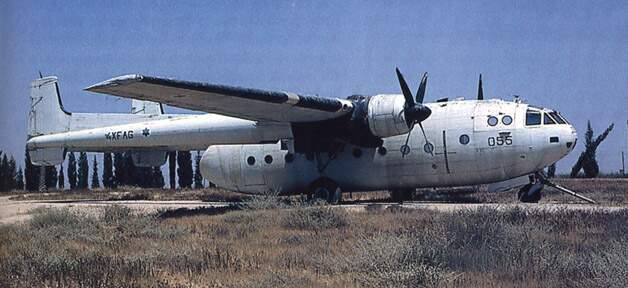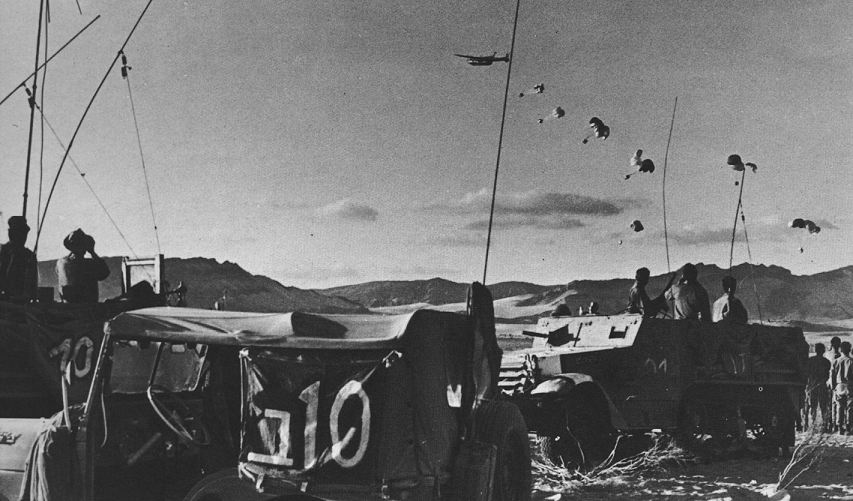
The Nord Noratlas was designed for the French Air Force as a replacement for the Douglas C-47 and Junkers Ju-52 which suffered from an aft sloping floor, restricting side loading doors and a limited payload. The prototype Nord 2500 first took to the air on September 10th 1949, but changes made to the original design resulted in the improved Nord 2501 whose first flight took place on November 28th 1950. Officially named Noratlas in January 1953, the first examples were delivered to the Armée de l'Air on June 12th. The type's distinctive characteristics were its twin booms supporting the tail unit, allowing for for a long uninterrupted hold terminating in rear clamshell doors. A total of 425 Noratlases were built, some remaining in civilian service well into the 1990s.
When France agreed to sell 12 Dassault Ouragans to Israel in 1955, it also insisted that Israel purchase 3 Nord Noratlases. The IAF did not want the Noratlas, a new aircraft that would require changes to its training and maintenance arrays. France, however, was the only country willing to sell jet fighters to Israel and the IAF grudgingly agreed to buy the new transport as well. This was the uninspired beginning of the type's long career with the IAF, during which it played an important part in Israel's various conflicts. Dan Tolkovsky, IAF Chief-of-Staff during the signing of the initial Noratlas deal, would later comment that this imposed sale turned out to be quite a blessing.

Two pilots and three mechanics from the 103rd "Elephants" transport squadron flew to France in September 1955 to study the new aircraft. On November 1st the first Israeli Noratlas landed at Tel-Nof AFB, flown by its Israeli crew, while the remaining two Noratlases were delivered during January 1956, this time by French crews. Commonly known as the Nord, the type was operated by the 103rd squadron alongside the IAF's C-47s.
The Nord provided the IAF with new capabilites which it soon put to good use. During April 1956 the Nords participated in the delievery of the IAF's Dassault Mystere IVAs, escorting the fighters on their way to Israel. More Mysteres were delievered during August, and once again they were escorted by Nords all the way from France to Israel. As tensions were increasing in the Middle East following the Egyptian nationalization of the Suez Canal in July 1956, A Nord especially fitted with additional fuel tanks carried the Israeli delegation sent to France to lay the foundation of Franco-Israeli military cooperation.
The IAF's three Nords saw extensive use during operation "Kadesh", Israel's part in the Suez Campaign launched on October 29th 1956. During the early hours of October 30th the three Nords begun dropping supplies to the paratroops at the Mitla Pass, a strategic point the troops had jumped into only a few hours
before. More such supply flights were flown on subsequent days while one Nord even landed at a makeshift airstrip to evacuate casualties. More flights were flown in support of the Israeli effort in the southern Sinai, flights that also envolved inserting forces behind enemy lines. In all, the three Nords flew 51
sorties between October 30th and November 5th, by which the fighting had stopped. Nord Noratlases were also extensively used by the French during the Suez Campaign, transporting men and supplies to Israel, dropping supplies to Israeli troops on the ground as well as during the French airborne assault on Port Said.
By the outbreak of the Six Days War in June 1967 the IAF had 23 Noratlases in its inventory, 16 of which were former West German examples. In the days leading up to the eruption of the war the Nords were employed on maritime patrol missions, a role they continued to play once fighting broke out on June 5th. As Israeli forces advanced through the Sinai, Nords were also active in their support, dropping supplies and ammunition as well as evacuating the wounded. On June 7th Nords were about to drop dozens of Israeli paratroops over Sharm-A-Sheik, an important stronghold at the southern tip of the Sinai, but instead disembarked them on the ground when it was discovered that the point had been abandoned. A single Nord was destroyed on June 5th in a Royal Jordanian Air Force strike against the IAF base at Sirkin. Sirkin was not actually an active air base at the time, but several Nords had been dispersed there to evade just such an attack! The Jordanians had apparently used out of date intelligence, from the time Sirkin was a flying base, home to the IAF flight school.

Noratlas dropping supplies during the Six Days War
The eruption of the War of Attrition following the Six Days War provided even more opportunities for the IAF's Noratlas fleet to prove its mettle. Throught the late 1960s, as the war raged on around the Suez Canal, the aircraft were employed delievering troops, supplies and ammunition to the front, evacuating wouded Israeli soldiers on their return flights. In two most unusual missions the Nords became the first and
only transport aircraft since the War of Independance to fly a bombing mission. In 1948 Israel had no other aircraft available for such a mission, but in 1969 8 Nords went on bombing missions deep into the heart of Egypt. The plans for these attacks were drawn up in the beginning of the 1969, their targets two bridges over the Nile river. The IAF selected the Nord for these missions for its large fuel and cargo loads, as
well as to demonstrate the IAF's capacity to strike at Egypt in the most innovative ways. On April 29th 4
Nords, two for each bridge, took off on operation "Batzoret" (drought) with rudimentry navigation maps and a bomb developed especially for the mission. While one pair managed to damage their intended target, the other pair missed their target and dropped their load on another bridge. The relative success of the operation inspired another such attack, operation "Tarnegol 169" (rooster 169). This time however, the Nords
were to overfly their targets before their bombing runs, and this almost brought the mission to a disasterous end. On October 26th 4 Nords once again took off on the seven hour flights into the heart of Egypt and back. While the first mission was a complete surprise, this time the Nords encountered a complete blackout over the Nile. When the aircraft reached their targets and attempted to carry out their overflights they were immediately fired upon by anti aircraft fire. Under heavy fire, some of the Nords completed their missions, dropping their bombloads on the bridges they were sent to destroy. One Nord however was heavily damaged and one of its engines destroyed while its companion's fuel tanks were ruptured. The pair, limping back to Israel, barely managed to land at an IAF base in the Sinai, one flying on one engine and the other on its last drops of fuel.
When the Yom Kippur War broke out on October 6th 1973 the Nords once again went into action, providing much needed support for Israeli troops on the various fronts. Their most important mission at the beginning of the war was ferrying much needed troops to the Egyptian front, while the rest of the war saw continues supply and evacuation flights. After 23 years in years service, the Nord was retired in 1978, replaced by the Lockheed C-130 Hercules. A number of Noratlases were sold to the Greek Air Force. Two Nords can be found at the IAF Museum at Hatzerim.
 back to the IDF/AF page
back to the IDF/AF page